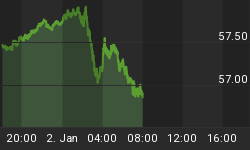The Fed raised its fed funds rate by 25 bps to 5.00%, the highest level since March 2001, maintaining the same language as in the March 28 meeting along with placing more emphasis on its data dependence.
May 10 FOMC: "...the extent and timing of any such firming will depend importantly on the evolution of the economic outlook."
Mar 27-28 FOMC: "In any event, the Committee will respond to changes in economic prospects as needed to foster these objectives."
By keeping its statement mostly unchanged -- except for the aforementioned phrase on data dependence -- the Fed has opted to avoid repeating Bernanke's dovish remarks from last month's Congressional testimony in order to stabilize any disorderly dollar declines, rein in further tightening in the long end of the curve and contain excess liquidity emerging in the rallying gold and stocks markets.
Using old central bank parlance, the Fed opted for maintaining its "tightening bias", which is the responsible course of action considering uncertainty in energy prices and the dollar decline.
We stated in our morning note that the Fed would: "sound off a relatively hawkish tone by not explicitly mentioning a conditional pause and ... keep the phrase: "some further policy firming may be needed" in order to slow the pace of the dollar decline". Our reasoning was founded on the premise that the dollar has fallen sufficiently rapidly to the extent of triggering inflationary pressures and the extent of fuelling disorderly declines in the event that it sounded a dovish tone.
The relatively hawkish statement (more hawkish than what some had anticipated) has lifted 10 year yields to 5.13% from 5.10% and 2-year yields to 5.00% from 4.93%. The broad lift along the yield curve means the fed funds rate will remain below the long end of the curve, which will be sufficient in maintaining markets expectations of a June rate hike.


US Treasury Throws Protectionist Ball Back at the Hill
There was no surprise in the US Treasury's decision to refrain from labeling China as a currency manipulator. But the Treasury engaged in a balancing act, of recognizing China's efforts in liberalizing its credit markets and currency market while criticizing the slow pace at which these reforms have taken place.
The Treasury has just thrown the ball back into Congress and the latter has taken it wholeheartedly;
Senator Baucus in the wires just called the Treasury's FX report "Irrelevant", advising that a new framework is needed, while Sen Schumer says legislation may be the only way to level the global playing field with China.
Interpretation:
The Treasury clearly means Congress will resurrect its protectionist rhetoric and threaten to slap China with trade action, which should contribute to the "protectionist element" of the dollar decline.
We reiterate that China's rate hike of (2 weeks ago hike may imply no revaluation / band increase until Q3
Last month's decision to raise its interest rates for the second time since 1995 was a signal to the G7 that financial market reform is not all about currency flexibility but also capital market liberalization, thus resorting to market mechanisms of raising the cost of debt instead of "administrative" measures.
Unlike in the October 2004 rate hike when the PBOC raised BOTH the lending rate and deposit rates by 27 bps to 5.58% and 2.25% respectively, today's 27-bp hike targeted only the lending rate, which reflects a concrete effort to:
1) Improve banks' capitalization/profitability;
2) Rein in consumer spending an cooling growth.
3) Ease speculation into yuan-denominated deposits
Since it is unlikely that China will adopt a currency and monetary tightening in the same quarter, we push forward our expectation for a revaluation/band increase to Q3.
















